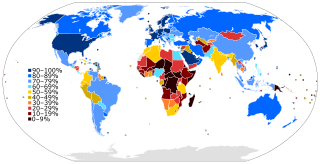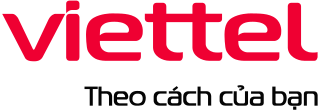Related Research Articles

Telecommunications in Ghana include radio, television, fixed and mobile telephones, and the Internet.
Telecommunications in Saudi Arabia have evolved early in the Kingdom since the establishment the Directorate of Post, Telephone and Telegraph (PTT) in 1926.

Iran's telecommunications industry is almost entirely state-owned, dominated by the Telecommunication Company of Iran (TCI). Fixed-line penetration in 2004 was relatively well-developed by regional standards, standing at 22 lines per 100 people, higher than Egypt with 14 and Saudi Arabia with 15, although behind the UAE with 27. Iran had more than 1 mobile phone per inhabitant by 2012.
The digital divide is the unequal access to digital technology, including smartphones, tablets, laptops, and the internet. The digital divide creates a division and inequality around access to information and resources. In the Information Age in which information and communication technologies (ICTs) have eclipsed manufacturing technologies as the basis for world economies and social connectivity, people without access to the Internet and other ICTs are at a socio-economic disadvantage, for they are unable or less able to find and apply for jobs, shop and learn.

Internet access is a facility or service that provides connectivity for a computer, a computer network, or other network device to the Internet, and for individuals or organizations to access or use applications such as email and the World Wide Web. Internet access is offered for sale by an international hierarchy of Internet service providers (ISPs) using various networking technologies. At the retail level, many organizations, including municipal entities, also provide cost-free access to the general public.
The global digital divide describes global disparities, primarily between developed and developing countries, in regards to access to computing and information resources such as the Internet and the opportunities derived from such access.

The Internet in Africa is limited by a lower penetration rate when compared to the rest of the world. Measurable parameters such as the number of ISP subscriptions, overall number of hosts, IXP-traffic, and overall available bandwidth are indicators that Africa is far behind the "digital divide". Moreover, Africa itself exhibits an inner digital divide, with most Internet activity and infrastructure concentrated in South Africa, Morocco, Egypt as well as smaller economies like Mauritius and Seychelles. In general, only 24.4% of the African population have access to the Internet, as of 2018. Only 0.4% of the African population has a fixed-broadband subscription. The majority of internet users use it through mobile broadband.
Over the past decade, there has been an increase in the use of information and communications technologies (ICTs) in China. As the largest developing country in the world, China faces a severe digital divide, which exists not only between mainland China and the developed countries, but also among its own regions and social groups.

Canada ranks as the 21st in the world for Internet usage with 31.77 million users as of July 2016 (est), making up 89.8% of the population. According to Harvard researchers, Canada has some of the lowest internet standards among OECD countries, as a result of high costs and slow internet speeds.

Internet in the Philippines first became available on March 29, 1994, 10:18 a.m., with the Philippine Network Foundation (PHNet) connecting the country and its people to Sprint in the United States via a 64 kbit/s link. As of February 2023, there are 85.16 million internet users in the country, where internet penetration stood at 73.1% of the total population.

Internet in India began in 1986 and was initially available only to the educational and research community. General public access to the internet in India began on 15 August 1995. American multinational digital communications technology conglomerate Cisco estimated that India will have more than 900 million internet users by 2023.
The Internet in Pakistan has been available since the early 1990s. Pakistan has about 130 million internet users, making it the 7th-largest population of internet users in the world. Information and communications technology (ICT) is one of the fastest growing industries in the country. In 2001 just 1.3% of the population used the Internet. By 2006 this figure had grown to 6.5% and in 2012 to 10.0%. As of July 2021; the percentage of internet users in Pakistan is 54%, which translates into approximately 118 million citizens having access to internet. Inadequate infrastructure is adversely impacting Internet speeds, encompassing technology, available backhaul, and international Internet bandwidth. This is the primary reason why Pakistan's Internet speed lags behind that of neighboring countries and even some less developed nations worldwide.
The Asia-America Gateway (AAG) is a 20,000-kilometre (12,000 mi) long submarine communications cable system, connecting South-East Asia with the mainland of the United States, across the Pacific Ocean via Guam and Hawaii.

Broadband is a term normally considered to be synonymous with a high-speed connection to the internet. Suitability for certain applications, or technically a certain quality of service, is often assumed. For instance, low round trip delay would normally be assumed to be well under 150ms and suitable for Voice over IP, online gaming, financial trading especially arbitrage, virtual private networks and other latency-sensitive applications. This would rule out satellite Internet as inherently high-latency. In some applications, utility-grade reliability or security are often also assumed or defined as requirements. There is no single definition of broadband and official plans may refer to any or none of these criteria.

The Viettel Military Industry and Telecoms Group, doing business as Viettel or Viettel Group, is a Vietnamese state-own multinational telecommunications and technology conglomerate headquartered in Hanoi, Vietnam, being the largest mobile network operator in its home country. The enterprise is run by the Vietnam Ministry of National Defence, making it a military-associated corporation.
The digital divide is described as the characterization of the gap between individuals or countries that have access to technology and individuals or countries that do not. This also includes, but is not limited to: access to computers, internet, and information literacy. General contributions to the digital divide are geography and next generational users. Next generational users are more involved with using devices that can connect to the internet, while the geography factor focuses more on how an individual's location put them at an advantage or disadvantage to compete with the digital age. However, only a handful on people and communities are being represented. Underdeveloped geographical locations, like certain regions of the continent of Africa serves as one of the underrepresented minorities. In particular, South Africa faces many developmental problems that make it one of the more complex societies in the world to map the digital divide in. The country is divided by ethnic inequality and discrepancies in the level of development between different sectors. These obstacles result in disparities in access to information and communications technology (ICT). This disparity is commonly known as the digital divide. There has been another major contributor, namely, Telkom and its monopolistic hold on the progress of ICT in South Africa. South Africa faces unique challenges in addressing the digital divide, including ethnic inequality, disparities in development levels between different sectors, and a historically monopolistic telecommunications industry. Efforts to bridge the digital divide in South Africa involve a combination of government initiatives, non-governmental organizations (NGOs), non-profit organizations (NPOs), and public-private partnerships, all working towards increasing access to technology, promoting digital literacy, and enhancing digital skills among the population.

The digital divide in Germany, the second most populous state and leading economic powerhouse in Europe, refers to the ever-growing gap between members of society without computer or Internet access and those with access. There are several factors contributing to the digital divide in Germany, including age, gender, family structure, education, ethnicity, and motivation. With a large market of Information and Communications Technology (ICT) in Germany, there are still areas that don't have access to high-speed internet. Internet access in Germany is more available in big cities compared to rural communities. The German government has taken initiative to increase internet access through the rural communities by adding free internet access throughout the communities, as well as, increase internet education in schools.

The digital divide is an economic and social inequality with regard to access to, use of, or impact of information and communication technologies (ICT). Factors causing the divide can vary depending on the country and culture, as can the potential solutions for minimizing or closing the divide.

The digital divide in Thailand refers to the economic, educational, and social inequalities between the Thai people who have access to information and communications technology (ICT) and those who do not. Thailand is a developing country within Southeast Asia, and is currently confronted with this problem. There are a number of factors that determine the digital divide within a country, including income, choice of technologies and socioeconomic factors. ICT development and mobile penetration are strongly correlated with economic growth and social benefits.

The digital divide in Colombia refers to inequalities between individuals, households, and other groups of different demographic and socioeconomic levels. More specifically, differences in access to information and communication technologies ("ICTs") and in the knowledge and skills needed to effectively use the information gained from connecting.
References
- ↑ Norris, P. 2001. Digital divide: Civic engagement, information poverty and the Internet world- wide. Cambridge, MA: Cambridge Univ. Press.
- ↑ "FALLING THROUGH THE NET: A Survey of the "Have Nots" in Rural and Urban America". doc.gov.
- ↑ Patricia, J.P. 2003. 'E-government, E-Asean Task force, UNDP-APDIP'(PDF)
- ↑ Mossberger, K., C.J. Tolbert, and M. Stansbury. 2003. Virtual inequality: Beyond the digital divide. Washington, DC: Georgetown University Press.
- ↑ "The World Factbook — Central Intelligence Agency". www.cia.gov. Archived from the original on June 12, 2007. Retrieved 2017-10-20.
- 1 2 "Up to 90% of Vietnamese to have Internet access: IT official - Tuoi Tre News". Tuoi Tre News (in Vietnamese). 23 February 2017. Retrieved 2017-10-17.
- ↑ "• Statista - The Statistics Portal for Market Data, Market Research and Market Studies". www.Statista.com. Retrieved 6 January 2018.
- ↑ "Daily internet usage in Vietnam by age group 2016 | Statistic". Statista. Retrieved 2017-11-29.
- ↑ "Global State of the Internet Connectivity Reports | Akamai" . Retrieved 2017-10-21.
- ↑ Telecom
- ↑ Corporation
- ↑ "Viettel". ViettelTelecom.vn. Retrieved 6 January 2018.
- 1 2 "Vietnam". freedomhouse.org. Retrieved 2017-10-21.
- 1 2 Ho, Victoria. "Vietnam 'blocks' Facebook over the weekend due to protests over dead fish". Mashable. Retrieved 2017-10-21.
- ↑ "Projects : Vietnam - ICT Development | The World Bank". projects.worldbank.org. Retrieved 2017-10-12.